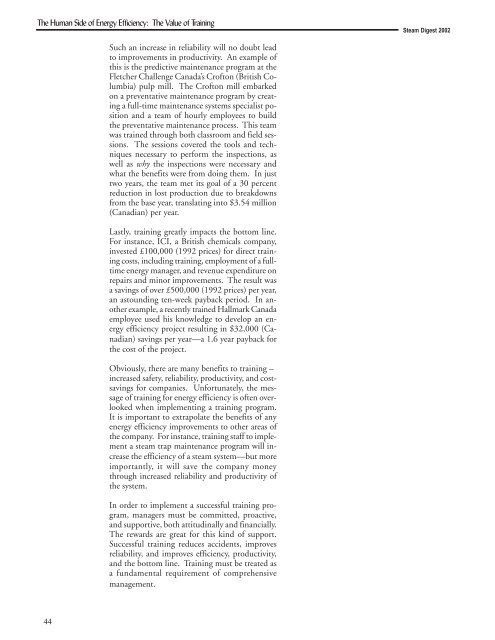Steam Digest 2002 - CiteSeerX
Steam Digest 2002 - CiteSeerX
Steam Digest 2002 - CiteSeerX
Create successful ePaper yourself
Turn your PDF publications into a flip-book with our unique Google optimized e-Paper software.
The Human Side of Energy Efficiency: The Value of Training<br />
44<br />
Such an increase in reliability will no doubt lead<br />
to improvements in productivity. An example of<br />
this is the predictive maintenance program at the<br />
Fletcher Challenge Canada’s Crofton (British Columbia)<br />
pulp mill. The Crofton mill embarked<br />
on a preventative maintenance program by creating<br />
a full-time maintenance systems specialist position<br />
and a team of hourly employees to build<br />
the preventative maintenance process. This team<br />
was trained through both classroom and field sessions.<br />
The sessions covered the tools and techniques<br />
necessary to perform the inspections, as<br />
well as why the inspections were necessary and<br />
what the benefits were from doing them. In just<br />
two years, the team met its goal of a 30 percent<br />
reduction in lost production due to breakdowns<br />
from the base year, translating into $3.54 million<br />
(Canadian) per year.<br />
Lastly, training greatly impacts the bottom line.<br />
For instance, ICI, a British chemicals company,<br />
invested £100,000 (1992 prices) for direct training<br />
costs, including training, employment of a fulltime<br />
energy manager, and revenue expenditure on<br />
repairs and minor improvements. The result was<br />
a savings of over £500,000 (1992 prices) per year,<br />
an astounding ten-week payback period. In another<br />
example, a recently trained Hallmark Canada<br />
employee used his knowledge to develop an energy<br />
efficiency project resulting in $32,000 (Canadian)<br />
savings per year—a 1.6 year payback for<br />
the cost of the project.<br />
Obviously, there are many benefits to training –<br />
increased safety, reliability, productivity, and costsavings<br />
for companies. Unfortunately, the message<br />
of training for energy efficiency is often overlooked<br />
when implementing a training program.<br />
It is important to extrapolate the benefits of any<br />
energy efficiency improvements to other areas of<br />
the company. For instance, training staff to implement<br />
a steam trap maintenance program will increase<br />
the efficiency of a steam system—but more<br />
importantly, it will save the company money<br />
through increased reliability and productivity of<br />
the system.<br />
In order to implement a successful training program,<br />
managers must be committed, proactive,<br />
and supportive, both attitudinally and financially.<br />
The rewards are great for this kind of support.<br />
Successful training reduces accidents, improves<br />
reliability, and improves efficiency, productivity,<br />
and the bottom line. Training must be treated as<br />
a fundamental requirement of comprehensive<br />
management.<br />
<strong>Steam</strong> <strong>Digest</strong> <strong>2002</strong>
















